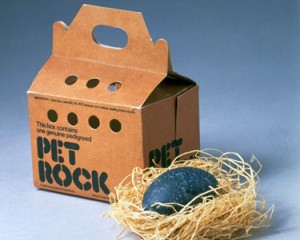https://www.youtube.com/watch?v=WBe9lyv6U_g
After watching the above video from youtube, it seems like consumers would purchase almost everything. The video shows 10 bizarre products and services that have managed to make a million dollar. One of the similarities of these 10 companies is that they know how to differentiate themselves from others. Their ideas are simple but they market them in a way that they actually create demand when there is a problem without a solution. From the video, the product that has caught my attention is The Pet Rock.
The Pet Rock
Basically, Pet Rock was created in 1975. The idea was originated from Gary Dahl, a salesman who became a millionaire after the success of the product. Animals are cute living creatures but most of them made a mess, misbehave at times and cost too much money. For him who actually had a pet rock himself, he believed that a rock was an ideal pet. He said, “it is easy,cheap and it had a great personality”. Although I am not to sure about what personality he is referring to, the people around that time did not think so. It was sold for over 5 million units for the first 6 months.
Instruction Manual
Surprisingly, the first edition of the pet was just an ordinary grey stone. It had no chemistry value and could easily be obtained for free. The marketing method of the product was the main reason that attracted sales. It was marketed like real living animals. What I find interesting is, the consumers were given an instruction manual that came with each set of their new pet. It had 32 pages and consisted of instructions on how to properly raise and care for the pet. In my opinion, this definitely appeals more to the psychological needs of consumers.
Will you buy it? For me myself, I am quite skeptical about spending $13 (its current price) on this product. But as much I do not want to admit, I might possibly have bought it if I were in 1975.
More information on the product:


